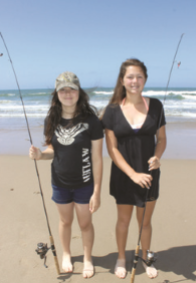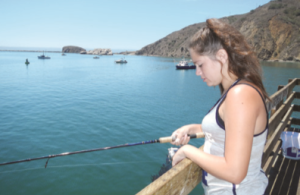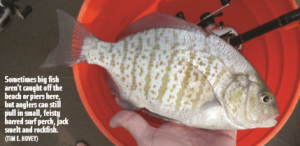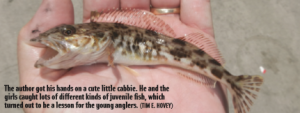Beat the Heat on Shore Leave
FISH THE CALIFORNIA COAST TO ESCAPE SUMMER’S SIZZLING INLAND TEMPERATURES, EVEN IF THE BIG ONE ISN’T CAUGHT
AVILA BEACH—
With summer heat and the drought conditions gripping  California, it doesn’t take much convincing for my family to head to the beach to fish. This time of year, we usually set aside one day during the weekend to drive to the shore to cast a line. Over the years, the girls and I have gotten pretty good at sampling the angling action down at the beach. We challenge each other, have good-natured contests and always keep count of how many fish we catch. We go to cool off, but the action there can be hot.
California, it doesn’t take much convincing for my family to head to the beach to fish. This time of year, we usually set aside one day during the weekend to drive to the shore to cast a line. Over the years, the girls and I have gotten pretty good at sampling the angling action down at the beach. We challenge each other, have good-natured contests and always keep count of how many fish we catch. We go to cool off, but the action there can be hot.
SURF’S UP
Early this summer we headed north for an annual family camping trip near Avila Beach. I checked out the surf fishing report, and even though the action looked slow, we were all excited to fish a brand-new shore.
Avila Beach is located in San Luis Bay, about 160 miles north of  Los Angeles and not far from more celebrated Pismo Beach. The beaches here are well protected and there are two piers open to the public. The surf in the bay is usually small and beach access is easy. We loaded the truck with gear and headed north. A few hours later, when we first spotted the large bay from the frontage road, we noticed some commotion between the two piers.
Los Angeles and not far from more celebrated Pismo Beach. The beaches here are well protected and there are two piers open to the public. The surf in the bay is usually small and beach access is easy. We loaded the truck with gear and headed north. A few hours later, when we first spotted the large bay from the frontage road, we noticed some commotion between the two piers.
A large group of people were gathered at the center of the fishing pier and looking towards the boat moorings. Gulls and pelicans hovered over a dark spot about 100 yards from the pier. Almost in unison a dozen flying birds fell from the sky and splashed into the calm sea. Additional splashes erupted around them as baitfish attempted to escape the predators from above and below.
While a bird diving into a large ball of bait is something to see, I found it hard to believe that the commotion was enough to draw such a crowd. But then the birds suddenly took flight – two whales erupted from the surface, mouths open, filling them with fresh fish. The signs of life in the bay had us all excited to toss a line.
After we got settled, we headed down to the beach and walked the boardwalk, checking out the sights. The whales were still splashing around in their food and the crowd had moved further down the pier, watching and taking pictures. We had decided to wait for a better tide and fish the next morning before the crowds took over the beach.
RIGHT PLACE, RIGHT TIME
We were out early and the girls and I headed out to fish the shore. The tide was perfect and the waves were small. The first beach was very shallow and we didn’t get any bites, so we shifted further south.
After a few casts, Alyssa, like she always does, hooked up first. She dragged a chunky barred surf perch through the surf. I could tell by her beaming smile that she wanted a photo, so I grabbed the camera. Less than five minutes later her sister, Jessica, hooked a perch. I added a very large jack smelt to the count before the fishing shut down.
 We spent another hour on the shore casting before we decided to call it quits. The sand crabs were there, but not in the numbers I had seen to the south. The reports had stated that the bite in and around Avila Beach was slow and the lack of bait was the reason.
We spent another hour on the shore casting before we decided to call it quits. The sand crabs were there, but not in the numbers I had seen to the south. The reports had stated that the bite in and around Avila Beach was slow and the lack of bait was the reason.
I really didn’t care. I had a great time walking the beach with my daughters, watching them catch fish and cast.
Long gone are the days where I do much for them on the shores anymore. They know how to rig, cast, catch and unhook. They aren’t tagalongs now; they’re my fishing buddies.
We ate dinner on the coast, and the girls decided that since the fishing was slow at the shore, we should try fishing from the pier the next day. After a quick breakfast, we beat the crowds and headed for the Port San Luis Pier, north of the fishing wharf at the center of the beach. I had fished this pier a few times as a boy and caught lots of juvenile rockfish.
We headed to the very end – that’s just what you do when you fish a pier – and tossed the rigs out. We started getting bites almost instantly, but hook-ups weren’t happening. I decided to rig up some smaller lines to see what was happening out in the bay.
Jessica was the first to pull one of the bait stealers from the bottom. She caught an 8-inch lingcod. The little fish was a perfect miniature of the toothy adult that lurks in the deep and eats 3-pound rockfish whole.
With the new rigs, we caught a dozen of them in half an hour. The current California Department of Fish and Wildlife regulations state that lingcod need to be 22 inches long to keep. The juvenile fish were way too small, and besides, we weren’t keeping anything on this trip.
ALL GROWN UP
During a lull in the fishing, I watched
the girls cast and attend to their gear. I thought about the early days of fishing, when I had to take care of everything. Now, when we headed out to fish, they grabbed the gear and they cast the lines. They have become proficient anglers.
 A few minutes later, Jessica hooked a different fish. She brought it over and showed me a juvenile cabezon, about 4 inches in length. Again the little sculpin was a perfect miniature of the adults I used to see diving. We carefully unhooked the fish and released it.
A few minutes later, Jessica hooked a different fish. She brought it over and showed me a juvenile cabezon, about 4 inches in length. Again the little sculpin was a perfect miniature of the adults I used to see diving. We carefully unhooked the fish and released it.
As we fished the rustic pier, the whales made a showing near the moorings adjacent to the wharf. We could see baitfish flail in midair as the huge mammals rushed the surface with their mouths gaping wide. Seagulls and pelicans dropped from the sky and feasted on the stunned and injured anchovies that floated near the surface.
I was lost in the natural moment when I heard Jessica comment on how much life there was in the little bay. She was watching the whales consume hundreds of pounds of fish in single gulps, and diving birds taking their share as well.
Life and death, I thought.
 Since the fishing had slowed, I decided to educate the girls on why we were catching so many juvenile fish in the bay. I told them the story of when I was 10 and how my parents let me and my brother fish this pier one afternoon.
Since the fishing had slowed, I decided to educate the girls on why we were catching so many juvenile fish in the bay. I told them the story of when I was 10 and how my parents let me and my brother fish this pier one afternoon.
Using tiny hooks and pieces of squid, we had caught dozens of juvenile bocaccio, a rust-red rockfish. In the times before size limits on this species, we took our catch back to our parent’s motor home and my mom cooked them all up for dinner.
I let the girls know that during my college days I worked on several marine contracts where we needed to drag sampling gear through this very bay for fish research. The hauls contained juvenile halibut and other species of juvenile rockfish. Now, bringing it back to our catch, the girls started to understand what types of fish were present in the bay. I told them that most bays and estuaries in California serve as nurseries for many species of fish, and thus are very important as far as the overall health of many of California’s  nearshore fisheries. The examples of feeding whales, diving birds and noisy sea lions also illustrated the bays’ importance.
nearshore fisheries. The examples of feeding whales, diving birds and noisy sea lions also illustrated the bays’ importance.
BIG ONES ARE OUT THERE
The whales had moved on and it was getting late. We packed everything up and started walking back to the parking area. At the foot of the pier was a small shop selling all sorts of seafood. The vendor had several large tanks filled with various sea creatures that were all for sale.
 In an acrylic tank near the walkway sat a grumpy-looking lingcod that weighed close to 20 pounds. I called the girls over and showed them the fish. I told them that this was an adult version of the ones we were catching at the end of the pier. They were both impressed with how huge those little fish could get.
In an acrylic tank near the walkway sat a grumpy-looking lingcod that weighed close to 20 pounds. I called the girls over and showed them the fish. I told them that this was an adult version of the ones we were catching at the end of the pier. They were both impressed with how huge those little fish could get.
One of the things I want both my daughters to realize is that just because you come back with an empty cooler doesn’t mean the day wasn’t successful. I want them to know that the reason I teach them to hunt and fish is for the experience rather than bringing home fish or game.
I want them to remember when they fished with me on a pier while whales fed nearby. I want them to take what they’ve learned at our home fishing spot and feel the pride of fishing a new beach with success. And I want them to understand how important respecting the resource is to our enjoyment. Watching them on the pier that day, I realized they probably already know all that. CS
By Tim E. Hovey



